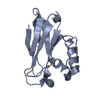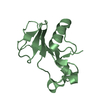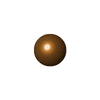[English] 日本語
 Yorodumi
Yorodumi- PDB-2hx9: Crystal structure of Cu(I) Azurin with the metal-binding loop seq... -
+ Open data
Open data
- Basic information
Basic information
| Entry | Database: PDB / ID: 2hx9 | ||||||
|---|---|---|---|---|---|---|---|
| Title | Crystal structure of Cu(I) Azurin with the metal-binding loop sequence "CTFPGHSALM" replaced with "CSPHQGAGM", at pH4 | ||||||
 Components Components | Azurin | ||||||
 Keywords Keywords |  ELECTRON TRANSPORT / BLUE COPPER-BINDING PROTEIN / GREEK-KEY BETA-BARREL / LOOP MUTAGENESIS ELECTRON TRANSPORT / BLUE COPPER-BINDING PROTEIN / GREEK-KEY BETA-BARREL / LOOP MUTAGENESIS | ||||||
| Function / homology |  Function and homology information Function and homology informationtransition metal ion binding /  electron transfer activity / electron transfer activity /  periplasmic space / copper ion binding / zinc ion binding / identical protein binding periplasmic space / copper ion binding / zinc ion binding / identical protein bindingSimilarity search - Function | ||||||
| Biological species |   Pseudomonas aeruginosa (bacteria) Pseudomonas aeruginosa (bacteria) | ||||||
| Method |  X-RAY DIFFRACTION / Direct use of Oxidised structure in same crystal form / Resolution: 1.7 Å X-RAY DIFFRACTION / Direct use of Oxidised structure in same crystal form / Resolution: 1.7 Å | ||||||
 Authors Authors | Banfield, M.J. | ||||||
 Citation Citation |  Journal: J.Am.Chem.Soc. / Year: 2007 Journal: J.Am.Chem.Soc. / Year: 2007Title: Engineering Copper Sites in Proteins: Loops Confer Native Structures and Properties to Chimeric Cupredoxins. Authors: Li, C. / Banfield, M.J. / Dennison, C. #1:  Journal: Proc.Natl.Acad.Sci.USA / Year: 2006 Journal: Proc.Natl.Acad.Sci.USA / Year: 2006Title: Basic requirements for a metal-binding site in a protein: The influence of loop shorteneing on the cupredoxin azurin Authors: Chan, L. / Yanagisawa, S. / Martins, B.M. / Messerschmidt, A. / Banfield, M.J. / Dennison, C. | ||||||
| History |
|
- Structure visualization
Structure visualization
| Structure viewer | Molecule:  Molmil Molmil Jmol/JSmol Jmol/JSmol |
|---|
- Downloads & links
Downloads & links
- Download
Download
| PDBx/mmCIF format |  2hx9.cif.gz 2hx9.cif.gz | 65.5 KB | Display |  PDBx/mmCIF format PDBx/mmCIF format |
|---|---|---|---|---|
| PDB format |  pdb2hx9.ent.gz pdb2hx9.ent.gz | 51.5 KB | Display |  PDB format PDB format |
| PDBx/mmJSON format |  2hx9.json.gz 2hx9.json.gz | Tree view |  PDBx/mmJSON format PDBx/mmJSON format | |
| Others |  Other downloads Other downloads |
-Validation report
| Arichive directory |  https://data.pdbj.org/pub/pdb/validation_reports/hx/2hx9 https://data.pdbj.org/pub/pdb/validation_reports/hx/2hx9 ftp://data.pdbj.org/pub/pdb/validation_reports/hx/2hx9 ftp://data.pdbj.org/pub/pdb/validation_reports/hx/2hx9 | HTTPS FTP |
|---|
-Related structure data
- Links
Links
- Assembly
Assembly
| Deposited unit | 
| ||||||||
|---|---|---|---|---|---|---|---|---|---|
| 1 | 
| ||||||||
| 2 | 
| ||||||||
| Unit cell |
|
- Components
Components
| #1: Protein |  Mass: 13785.544 Da / Num. of mol.: 2 / Mutation: Metal binding loop Source method: isolated from a genetically manipulated source Source: (gene. exp.)   Pseudomonas aeruginosa (bacteria) / Gene: azu / Plasmid: TRK99A / Production host: Pseudomonas aeruginosa (bacteria) / Gene: azu / Plasmid: TRK99A / Production host:   Escherichia coli (E. coli) / Strain (production host): JM101 / References: UniProt: P00282 Escherichia coli (E. coli) / Strain (production host): JM101 / References: UniProt: P00282#2: Chemical |  Copper Copper#3: Water | ChemComp-HOH / |  Water Water |
|---|
-Experimental details
-Experiment
| Experiment | Method:  X-RAY DIFFRACTION / Number of used crystals: 1 X-RAY DIFFRACTION / Number of used crystals: 1 |
|---|
- Sample preparation
Sample preparation
| Crystal | Density Matthews: 2.21 Å3/Da / Density % sol: 44.41 % |
|---|---|
Crystal grow | Temperature: 293 K / Method: vapor diffusion, hanging drop / pH: 5 Details: 29-31% PEG 4000, 100mM magnesium chloride, 100mM Sodium acetate. Crystal soaked in pH4 buffer and ascorbate following growth, pH 5, VAPOR DIFFUSION, HANGING DROP, temperature 293K |
-Data collection
| Diffraction | Mean temperature: 93 K |
|---|---|
| Diffraction source | Source:  ROTATING ANODE / Type: RIGAKU / Wavelength: 1.542 Å ROTATING ANODE / Type: RIGAKU / Wavelength: 1.542 Å |
| Detector | Type: RIGAKU RAXIS IV / Detector: IMAGE PLATE / Date: Mar 15, 2006 / Details: Osmic "blue" |
| Radiation | Monochromator: Ni Filter / Protocol: SINGLE WAVELENGTH / Monochromatic (M) / Laue (L): M / Scattering type: x-ray |
| Radiation wavelength | Wavelength : 1.542 Å / Relative weight: 1 : 1.542 Å / Relative weight: 1 |
| Reflection | Resolution: 1.7→54.233 Å / Num. obs: 27616 / % possible obs: 99.9 % / Observed criterion σ(F): 0 / Observed criterion σ(I): 0 / Redundancy: 5.1 % / Biso Wilson estimate: 20 Å2 / Rmerge(I) obs: 0.053 / Rsym value: 0.053 / Net I/σ(I): 10.3 |
| Reflection shell | Resolution: 1.7→1.79 Å / Redundancy: 4.9 % / Rmerge(I) obs: 0.293 / Mean I/σ(I) obs: 2.6 / Num. measured all: 19566 / Num. unique all: 3968 / Rsym value: 0.293 / % possible all: 100 |
- Processing
Processing
| Software |
| ||||||||||||||||||||||||||||||||||||||||||||||||||||||||||||||||||||||||||||||||||||||||||
|---|---|---|---|---|---|---|---|---|---|---|---|---|---|---|---|---|---|---|---|---|---|---|---|---|---|---|---|---|---|---|---|---|---|---|---|---|---|---|---|---|---|---|---|---|---|---|---|---|---|---|---|---|---|---|---|---|---|---|---|---|---|---|---|---|---|---|---|---|---|---|---|---|---|---|---|---|---|---|---|---|---|---|---|---|---|---|---|---|---|---|---|
| Refinement | Method to determine structure : Direct use of Oxidised structure in same crystal form : Direct use of Oxidised structure in same crystal formResolution: 1.7→33 Å / Cor.coef. Fo:Fc: 0.96 / Cor.coef. Fo:Fc free: 0.934 / SU B: 1.974 / SU ML: 0.067 / Cross valid method: THROUGHOUT / σ(F): 0 / ESU R: 0.109 / ESU R Free: 0.112 / Stereochemistry target values: MAXIMUM LIKELIHOOD Details: HYDROGENS HAVE BEEN ADDED IN THE RIDING POSITIONS, but not output to final file
| ||||||||||||||||||||||||||||||||||||||||||||||||||||||||||||||||||||||||||||||||||||||||||
| Solvent computation | Ion probe radii: 0.8 Å / Shrinkage radii: 0.8 Å / VDW probe radii: 1.4 Å / Solvent model: MASK | ||||||||||||||||||||||||||||||||||||||||||||||||||||||||||||||||||||||||||||||||||||||||||
| Displacement parameters | Biso mean: 18.514 Å2
| ||||||||||||||||||||||||||||||||||||||||||||||||||||||||||||||||||||||||||||||||||||||||||
| Refinement step | Cycle: LAST / Resolution: 1.7→33 Å
| ||||||||||||||||||||||||||||||||||||||||||||||||||||||||||||||||||||||||||||||||||||||||||
| Refine LS restraints |
| ||||||||||||||||||||||||||||||||||||||||||||||||||||||||||||||||||||||||||||||||||||||||||
| LS refinement shell | Resolution: 1.701→1.745 Å / Total num. of bins used: 20
|
 Movie
Movie Controller
Controller



















 PDBj
PDBj


